
Juncaceae is a family of flowering plants, commonly known as the rush family. It consists of 8 genera and about 464 known species of slow-growing, rhizomatous, herbaceous monocotyledonous plants that may superficially resemble grasses and sedges. They often grow on infertile soils in a wide range of moisture conditions. The best-known and largest genus is Juncus. Most of the Juncus species grow exclusively in wetland habitats. A few rushes, such as Juncus bufonius are annuals, but most are perennials.

Juncus is a genus of monocotyledonous flowering plants, commonly known as rushes. It is the largest genus in the family Juncaceae, containing around 300 species.

Juncus effususis a perennial herbaceous flowering plant species in the rush family Juncaceae, with the common names common rush or soft rush. In North America, the common name soft rush also refers to Juncus interior.

Juncus acutus, the spiny rush, sharp rush or sharp-pointed rush, is a flowering plant in the monocot family Juncaceae. It is native to the Americas, Northern and Southern Africa, Western and Southern Europe and West Asia, and is found in a variety of wet habitats, such as bogs, fens, meadows, and salt marshes, and along the edges of ponds and lakes.

Juncus balticus is a species of rush known by the common name Baltic rush. It is a perennial flowering plant in the family Juncaceae. This plant can reach a height of about 75 cm. It is native to maritime areas of northern Britain, the Baltic and Scandinavia, western Europe, North America and western South America. It is available from specialist nurseries for landscaping and soil stabilization purposes.

Juncus kraussii commonly known as salt marsh rush, sea rush, jointed rush, matting rush or dune slack rush, is of the monocot family Juncaceae and genus Juncus. It grows in salt marshes, estuarine and coastal areas.

Juncus pallidus, commonly known as the great soft-rushpale rush, giant rush, or leafless rush is a species of rush that is native to southern Australia, New Zealand, Norfolk Island, and Lord Howe Island. It is a vigorous, tufted, tussock-forming, rhizomatous perennial herb with culms growing to 70–135 cm in height. The inflorescence, which is 25–185 mm long, contains many straw coloured flowers, each with six floral segments. It is usually found in moist, nutrient-poor soils subject to periodic flooding, such as fresh and brackish waterways, including swamps, creek banks, lake edges and sand seeps.

Juncus filiformis, called the thread rush, is a species of flowering plant in the genus Juncus, with a circumboreal distribution. It has been introduced to South Georgia Island. It is typically found in wetlands, on the borders of lakes and streams.

Juncus bulbosus, the bulbous rush, is a species of flowering plant in the genus Juncus, native to Iceland, the Faroes, Europe, Macaronesia, and northwest Africa. It has been introduced to Australia, New Zealand, and some locations in northern North America. It is capable of nuisance growth in lakes and streams.

Juncus inflexus, the hard rush, is a species of flowering plant in the family Juncaceae, native to Europe, Asia and Africa, and introduced in Sri Lanka, Java, Île Amsterdam and Île Saint-Paul, Victoria in Australia, New Zealand, Uruguay, and eastern North America. It is a glycophyte (non-halophyte).
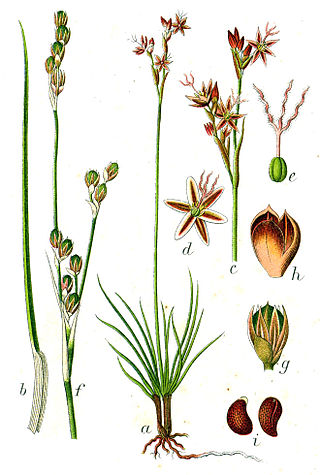
Juncus squarrosus, called goose corn, heath rush, and mosquito rush, is a species of flowering plant in the genus Juncus, native to Iceland, Europe, and Morocco, and introduced to Greenland, Svalbard, Tasmania, New Zealand, and the US state of Wisconsin. It is pollution-tolerant.

Juncus alpinoarticulatus, called the northern green rush and the alpine rush, is a species of flowering plant in the genus Juncus, with a circumboreal distribution. It prefers wet sandy soils, peat bogs, acidic fens, and ditches.
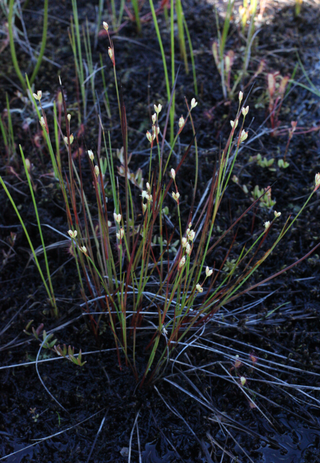
Juncus stygius, called the bog rush and moor rush, is a species of flowering plant in the genus Juncus, with a high circumboreal distribution, never reaching further south than Switzerland, Korea and Upstate New York.

Juncus canadensis, called the Canadian rush, is a species of flowering plant in the genus Juncus, native to central and eastern Canada and the central and eastern United States, and introduced to Oregon, New Zealand, and the Low Countries in Europe. It is an obligate wetland species.
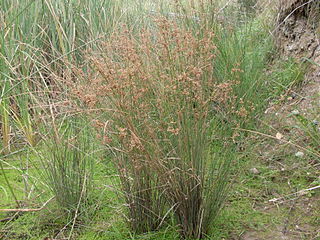
Juncus usitatus, the common rush, is a species of flowering plant in the rush family, Juncaceae. A graceful, clumping plant growing from 40 cm to 1.1 metres high. Commonly found in New Zealand and eastern Australia in disturbed sites by stream banks and other moist habitats. The specific epithet is derived from Latin, meaning "common or usual".
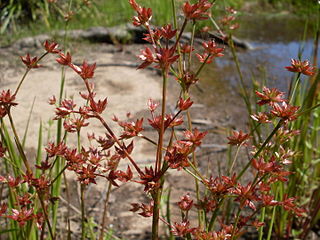
Juncus prismatocarpus, the branching rush, is a tufted, perennial species of flowering plant in the rush family, Juncaceae. Found in moist situations, often on sandy ground. Grass-like leaves are 10 to 40 cm long, 1.3 to 3.0 mm in diameter. Growing in many parts of Australia, New Zealand and south east Asia. The specific epithet is derived from Latin, meaning prism shaped fruit.

Juncus homalocaulis is a species of flowering plant in the rush family, Juncaceae. A tufted, perennial plant growing from 5 cm to 35 cm tall, with stems 0.5 to 1.2 mm thick. Often found in Australia and New Zealand in moist grassland or woodland. The specific epithet is derived from Greek, meaning "even stem".
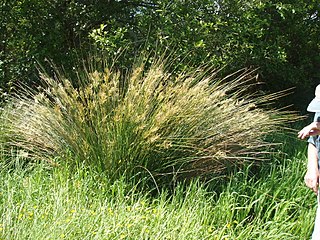
Juncus sarophorus, the broom rush or fan-flowered rush, is a species of flowering plant in the family Juncaceae. Native to southeastern Australia, and all of New Zealand except the Kermadec Islands, it also has been introduced to Great Britain. A dense tussock-forming perennial of wet areas, and somewhat weedy, its stems reach 2 m (6 ft) long but droop so that the plant overall is closer to 1 m (3 ft) tall.

Juncus pelocarpus, the brown-fruit rush, is a species of flowering plant in the family Juncaceae, native to British Columbia and eastern Canada, and the north-central and eastern United States. A colonial perennial 1 to 12 in tall, it is found in wet areas.
Juncus filicaulis, the thread rush, is a species of flowering plant in the family Juncaceae. It is native to southeastern Australia, and it has been introduced to New Zealand. A perennial reaching 45 cm (18 in), it forms dense tufts.


















